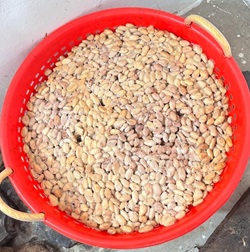Quality of the finished product is dependent on factors like the type or variety grown, agrotechniques adopted, environmental conditions during the development of the pod and the processing technology. It is therefore important on the part of everybody involved in production and processing to do everything possible to maintain and improve standards of quality. Growing cocoa by providing the optimum conditions and harvesting at the right stage of maturity at farmer's level and adoption of the right methods for processing at manufacturer's level are very critical for ensuring quality. Faulty processing can lead to deterioration of quality of even the best quality beans. However, post harvest losses are comparatively less in cocoa as quantity of cocoa processed at farmers' level is negligible.

PRIMARY PROCESSING
Primary processing refers to the initial stage of preparing cocoa beans for market consumption, involving the crucial steps of fermentation and drying.
1. FERMENTATION
Chocolate flavour is developed during the two processes viz. fermentation, which is done by the farmer/manufacturer, and roasting, done by the manufacturer which involves keeping together a mass reasonable quantity of wet beans. As a result of fermentation, most of the pulp around the beans is lost. During fermentation, a series of biochemical actions occurs in the beans. With the help of organisms such as yeast and a variety of bacteria, a variety of reactions occurs during fermentation giving the beans the aroma and taste that is present in the chocolate.
METHODS OF FERMENTATION
The duration and method of cocoa fermentation are primarily influenced by the cocoa type and prevailing seasonal conditions.
There are various methods of fermenting cocoa beans, each with its own variations and regional practices. Some common methods include:
- Heap Method
- Basket or Tray Fermentation
- Plastic gunny bag method



2. DRYING
During the drying of fermented cocoa beans, fermentation reactions continue during drying as well. Biochemical oxidation of acetic acid from the beans continues during drying. A very slow drying also will not suit as the beans get moldy if they continue to remain moist for too long.
Two method of drying are recommended:
1. Sun drying
2. Artificial drying
3. CLEANING AND BAGGING
The dried beans are bagged in jute bags, after removing flat and broken beans.
STORAGE
Dry cocoa beans can be stored for a long under suitable conditions. However, the period of safe storage will depend mainly on the relative humidity and temperature of the atmosphere in which the beans are stored.
SECONDARY PROCESSING
Secondary processing is carried out to obtain the final product "Chocolate".
COCOA PRODUCTS
1.MILK CHOCOLATE
The method of preparation remains the same as described above for plain chocolate. The only difference is that milk or milk powder is added at the first stage of mixing mass with sugar.
2. WHITE CHOCOLATE
This is made of milk, cocoa butter and sugar.
OTHER COCOA BASED PRODUCTS
A number of products are now available in the market- drinking chocolate, Cocoa Chocos, Cocoa Bite, Cocoa Delite, White Delite, Nutribar, Nutrimix, Cocoa Chubby, Cocoa Cruncho, Sipup, Icecream, Cookies, Dark chocolate, Chocolate 4 u, Choco Pea and Chocolate flavoured milk.




